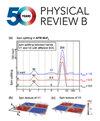Nonreciprocal spin-wave dispersion in magnetic bilayers
IF 3.7
2区 物理与天体物理
Q1 Physics and Astronomy
引用次数: 0
Abstract
Nonreciprocal spin-wave propagation in bilayer ferromagnetic systems has attracted significant attention due to its potential to precisely quantify material parameters as well as for applications in magnonic logic and information processing. In this paper, we investigate the nonreciprocity of spin-wave dispersions in heterostructures consisting of two distinct ferromagnetic materials, focusing on the influence of saturation magnetization and thickness of the magnetic layers. We exploit Brillouin light scattering to confirm numerical calculations which are conducted with the finite element software . An extensive numerical analysis reveals that the nonreciprocal behavior is strongly influenced by the changing material parameters, with asymmetry in the spin-wave propagation direction reaching several GHz under optimized conditions. Our findings demonstrate that tailoring the bilayer composition enables precise control over nonreciprocity, providing a pathway for engineering efficient unidirectional spin-wave devices. These results offer a deeper understanding of hybrid ferromagnetic systems and open avenues for designing advanced magnonic circuits.磁双层中的非互易自旋波色散
双层铁磁系统中的非互易自旋波传播由于具有精确量化材料参数的潜力以及在磁逻辑和信息处理中的应用而引起了人们的极大关注。本文研究了由两种不同铁磁材料组成的异质结构中自旋波色散的非互易性,重点研究了饱和磁化强度和磁层厚度对自旋波色散的影响。我们利用布里渊光散射来验证用有限元软件进行的数值计算。广泛的数值分析表明,材料参数的变化对自旋波的非互易行为有很大的影响,在优化条件下,自旋波传播方向的不对称性达到了几个GHz。我们的研究结果表明,调整双层结构可以精确控制非互易性,为设计高效的单向自旋波器件提供了途径。这些结果提供了对混合铁磁系统的更深入的理解,并为设计先进的磁电路开辟了道路。2025年由美国物理学会出版
本文章由计算机程序翻译,如有差异,请以英文原文为准。
求助全文
约1分钟内获得全文
求助全文
来源期刊

Physical Review B
物理-物理:凝聚态物理
CiteScore
6.70
自引率
32.40%
发文量
0
审稿时长
3.0 months
期刊介绍:
Physical Review B (PRB) is the world’s largest dedicated physics journal, publishing approximately 100 new, high-quality papers each week. The most highly cited journal in condensed matter physics, PRB provides outstanding depth and breadth of coverage, combined with unrivaled context and background for ongoing research by scientists worldwide.
PRB covers the full range of condensed matter, materials physics, and related subfields, including:
-Structure and phase transitions
-Ferroelectrics and multiferroics
-Disordered systems and alloys
-Magnetism
-Superconductivity
-Electronic structure, photonics, and metamaterials
-Semiconductors and mesoscopic systems
-Surfaces, nanoscience, and two-dimensional materials
-Topological states of matter
 求助内容:
求助内容: 应助结果提醒方式:
应助结果提醒方式:


